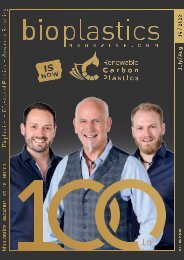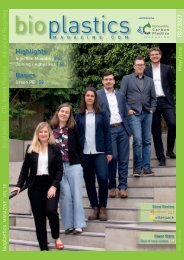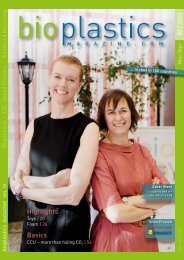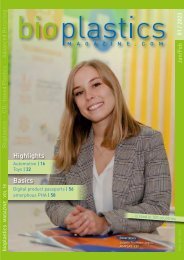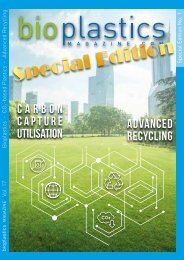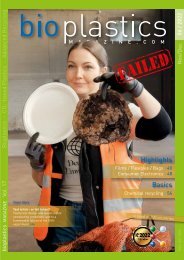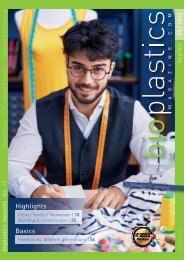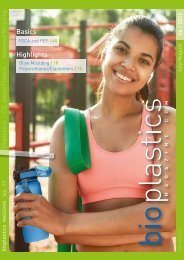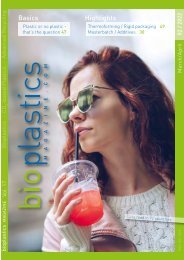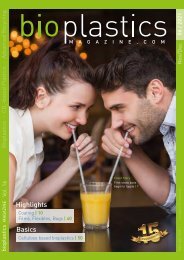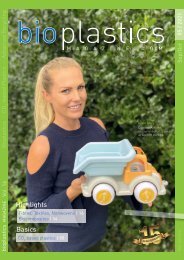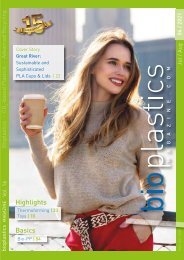Issue 06/2020
Highlights: Films / Flexibles Bioplastics from waste-streams Basics: Eutrophication
Highlights:
Films / Flexibles
Bioplastics from waste-streams
Basics: Eutrophication
You also want an ePaper? Increase the reach of your titles
YUMPU automatically turns print PDFs into web optimized ePapers that Google loves.
Basics<br />
for when their sources of nutrition become<br />
scarce. By farming this type of bacteria, and<br />
feeding them on sugar or starch (mostly from<br />
maize), or at times on plant oils or other nutrients<br />
rich in carbonates, it is possible to<br />
obtain PHA‘s on an industrial scale [11]. The<br />
most common types of PHA are PHB (Polyhydroxybutyrate,<br />
PHBV and PHBH. Depending<br />
on the bacteria and their food, PHAs with<br />
different mechanical properties, from rubbery<br />
soft trough stiff and hard as ABS, can be produced.<br />
Some PHAs are even biodegradable in<br />
soil or in marine environment.<br />
PLA | Polylactide or polylactic acid (PLA), a<br />
biodegradable, thermoplastic, linear aliphatic<br />
polyester based on lactic acid, a natural acid,<br />
is mainly produced by fermentation of sugar<br />
or starch with the help of micro-organisms.<br />
Lactic acid comes in two isomer forms, i.e. as<br />
laevorotatory D(-)lactic acid and as dextrorotary<br />
L(+)lactic acid.<br />
Modified PLA types can be produced by the<br />
use of the right additives or by certain combinations<br />
of L- and D- lactides (stereocomplexing),<br />
which then have the required rigidity for<br />
use at higher temperatures [13]. [bM 01/09, 01/12]<br />
Plastics | Materials with large molecular<br />
chains of natural or fossil raw materials, produced<br />
by chemical or biochemical reactions.<br />
PPC | Polypropylene carbonate, a bioplastic<br />
made by copolymerizing CO 2<br />
with propylene<br />
oxide (PO). [bM 04/12]<br />
PTT | Polytrimethylterephthalate (PTT), partially<br />
biobased polyester, is similarly produced<br />
to PET using terephthalic acid or dimethyl<br />
terephthalate and a diol. In this case it is a<br />
biobased 1,3 propanediol, also known as bio-<br />
PDO. [bM 01/13, 04/20]<br />
Renewable resources | Agricultural raw materials,<br />
which are not used as food or feed,<br />
but as raw material for industrial products<br />
or to generate energy. The use of renewable<br />
resources by industry saves fossil resources<br />
and reduces the amount of → greenhouse gas<br />
emissions. Biobased plastics are predominantly<br />
made of annual crops such as corn, cereals,<br />
and sugar beets or perennial cultures<br />
such as cassava and sugar cane.<br />
Resource efficiency | Use of limited natural<br />
resources in a sustainable way while minimising<br />
impacts on the environment. A resource-efficient<br />
economy creates more output<br />
or value with lesser input.<br />
Seedling logo | The compostability label or<br />
logo Seedling is connected to the standard<br />
EN 13432/EN 14995 and a certification process<br />
managed by the independent institutions<br />
→ DIN CERTCO and → TÜV Austria. Bioplastics<br />
products carrying the Seedling fulfil the<br />
criteria laid down in the EN 13432 regarding<br />
industrial compostability. [bM 01/<strong>06</strong>, 02/10]<br />
Saccharides or carbohydrates | Saccharides<br />
or carbohydrates are names for the sugarfamily.<br />
Saccharins are monomer or polymer<br />
sugar units. For example, there are known<br />
mono-, di- and polysaccharides. → glucose is<br />
a monosaccaride. They are important for the<br />
diet and produced biology in plants.<br />
Semi-finished products | Pplastic in form of<br />
sheet, film, rods or the like to be further processed<br />
into finished products.<br />
Sorbitol | Sugar alcohol, obtained by reduction<br />
of glucose changing the aldehyde group<br />
to an additional hydroxyl group. It is used as<br />
a plasticiser for bioplastics based on starch.<br />
Starch | Natural polymer (carbohydrate)<br />
consisting of → amylose and → amylopectin,<br />
gained from maize, potatoes, wheat, tapioca<br />
etc. When glucose is connected to polymerchains<br />
in a definite way the result (product) is<br />
called starch. Each molecule is based on 300<br />
-12000-glucose units. Depending on the connection,<br />
there are two types known → amylose<br />
and → amylopectin. [bM 05/09]<br />
Starch derivatives | are based on the chemical<br />
structure of → starch. The chemical structure<br />
can be changed by introducing new functional<br />
groups without changing the → starch<br />
polymer. The product has different chemical<br />
qualities. Mostly the hydrophilic character is<br />
not the same.<br />
Starch-ester | One characteristic of every<br />
starch-chain is a free hydroxyl group. When<br />
every hydroxyl group is connected with an<br />
acid the product is starch-ester with different<br />
chemical properties.<br />
Starch propionate and starch butyrate | can<br />
be synthesised by treating the → starch with<br />
propane or butanoic acid. The product structure<br />
is still based on → starch. Every based →<br />
glucose fragment is connected with a propionate<br />
or butyrate ester group. The product is<br />
more hydrophobic than → starch.<br />
Sustainable | An attempt to provide the best<br />
outcomes for the human and natural environments<br />
both now and into the indefinite future.<br />
One famous definition of sustainability is the<br />
one created by the Brundtland Commission,<br />
led by the former Norwegian Prime Minister<br />
G. H. Brundtland. It defined sustainable development<br />
as development that ‘meets the<br />
needs of the present without compromising<br />
the ability of future generations to meet their<br />
own needs.’ Sustainability relates to the continuity<br />
of economic, social, institutional and<br />
environmental aspects of human society, as<br />
well as the non-human environment.<br />
Sustainable sourcing | of renewable feedstock<br />
for biobased plastics is a prerequisite<br />
for more sustainable products. Impacts such<br />
as the deforestation of protected habitats<br />
or social and environmental damage arising<br />
from poor agricultural practices must<br />
be avoided. Corresponding certification<br />
schemes, such as ISCC PLUS, WLC or Bon-<br />
Sucro, are an appropriate tool to ensure the<br />
sustainable sourcing of biomass for all applications<br />
around the globe.<br />
Sustainability | as defined by European Bioplastics,<br />
has three dimensions: economic, social<br />
and environmental. This has been known<br />
as “the triple bottom line of sustainability”.<br />
This means that sustainable development involves<br />
the simultaneous pursuit of economic<br />
prosperity, environmental protection and social<br />
equity. In other words, businesses have<br />
to expand their responsibility to include these<br />
environmental and social dimensions. Sustainability<br />
is about making products useful to<br />
markets and, at the same time, having societal<br />
benefits and lower environmental impact<br />
than the alternatives currently available. It also<br />
implies a commitment to continuous improvement<br />
that should result in a further reduction<br />
of the environmental footprint of today’s products,<br />
processes and raw materials used.<br />
Thermoplastics | Plastics which soften or<br />
melt when heated and solidify when cooled<br />
(solid at room temperature).<br />
Thermoplastic Starch | (TPS) → starch that<br />
was modified (cooked, complexed) to make it<br />
a plastic resin.<br />
Thermoset | Plastics (resins) which do not<br />
soften or melt when heated. Examples are<br />
epoxy resins or unsaturated polyester resins.<br />
TÜV Austria Belgium | Independent certifying<br />
organisation for the assessment on the conformity<br />
of bioplastics (formerly Vinçotte).<br />
Vinçotte | → TÜV Austria Belgium<br />
WPC | Wood Plastic Composite. Composite<br />
materials made of wood fibre/flour and plastics<br />
(mostly polypropylene).<br />
Yard Waste | Grass clippings, leaves, trimmings,<br />
garden residue.<br />
References:<br />
[1] Environmental Communication Guide,<br />
European Bioplastics, Berlin, Germany,<br />
2012<br />
[2] ISO 14<strong>06</strong>7. Carbon footprint of products -<br />
Requirements and guidelines for quantification<br />
and communication<br />
[3] CEN TR 15932, Plastics - Recommendation<br />
for terminology and characterisation<br />
of biopolymers and bioplastics, 2010<br />
[4] CEN/TS 16137, Plastics - Determination<br />
of bio-based carbon content, 2011<br />
[5] ASTM D6866, Standard Test Methods for<br />
Determining the Biobased Content of<br />
Solid, Liquid, and Gaseous Samples Using<br />
Radiocarbon Analysis<br />
[6] SPI: Understanding Biobased Carbon<br />
Content, 2012<br />
[7] EN 13432, Requirements for packaging<br />
recoverable through composting and biodegradation.<br />
Test scheme and evaluation<br />
criteria for the final acceptance of packaging,<br />
2000<br />
[8] Wikipedia<br />
[9] ISO 14<strong>06</strong>4 Greenhouse gases -- Part 1:<br />
Specification with guidance..., 20<strong>06</strong><br />
[10] Terrachoice, 2010, www.terrachoice.com<br />
[11] Thielen, M.: Bioplastics: Basics. Applications.<br />
Markets, Polymedia Publisher,<br />
2012<br />
[12] Lörcks, J.: Biokunststoffe, Broschüre der<br />
FNR, 2005<br />
[13] de Vos, S.: Improving heat-resistance of<br />
PLA using poly(D-lactide),<br />
bioplastics MAGAZINE, Vol. 3, <strong>Issue</strong> 02/2008<br />
[14] de Wilde, B.: Anaerobic Digestion, bioplastics<br />
MAGAZINE, Vol 4., <strong>Issue</strong> <strong>06</strong>/2009<br />
[15] ISO 14<strong>06</strong>7 onb Corbon Footprint of<br />
Products<br />
[16] ISO 14021 on Self-declared Environmental<br />
claims<br />
[17] ISO 14044 on Life Cycle Assessment<br />
bioplastics MAGAZINE [<strong>06</strong>/20] Vol. 15 57





